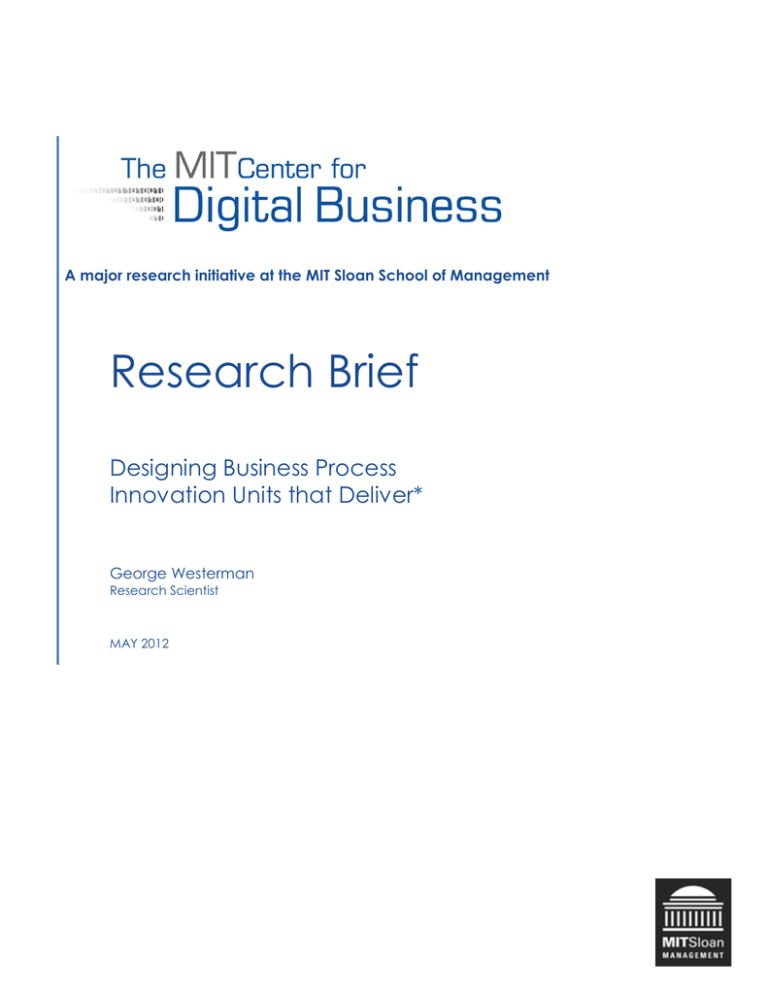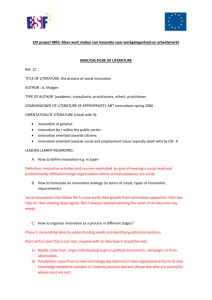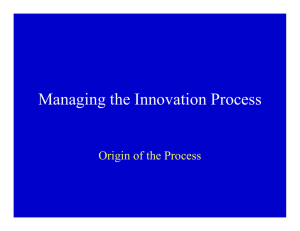Research Brief Designing Business Process Innovation Units that Deliver*
advertisement

A major research initiative at the MIT Sloan School of Management Research Brief Designing Business Process Innovation Units that Deliver* George Westerman Research Scientist MAY 2012 For more information, please visit our website, or contact us directly by email or phone: digital.mit.edu digital@mit.edu (617) 253-7054 Introduction In trying to make your company more innovative, are you looking in the wrong places? By framing innovation in terms of breakthrough products and customer experiences, you may be asking for more than your organization is ready to handle. Business process innovation can deliver breakthrough improvements in cost and service quality faster and at lower risk than product innovation activities. Business process innovators can deliver value now and, by engaging key employees in their experiments, can change the innovation culture of the enterprise. Start by investing a small amount to create a business process innovation unit. Our research found six principles that characterize successful process innovation units. These units are simultaneously Sponsored, Separate, Small, Systematic, Shared, and Seen (Figure 1). No process innovation unit that we studied survived beyond three years with fewer than five of the six principles. And any missing principle created predictable challenges for the innovators. The first three principles relate to the innovation unit itself. The other three principles govern how the innovation unit interacts with the rest of the organization. While it can be difficult to ensure that all six principles are mature from the start, all are required for the unit to achieve long-term success. SPONSORED Innovation units get their funding and mandate from a sponsor. However, sponsorship does not stop there. Effective sponsors do more than just provide funding; they actively protect and promote the unit. Leaders of successful innovation units talk of how their sponsors step in as needed to protect the unit’s funding or justify its methods. Active sponsors also encourage people throughout the company to engage with the unit by appearing at innovation events, issuing formal communications, and informally promoting the unit to other executives. And the most effective sponsors continually challenge the unit’s leader -- and its members – to improve productivity and value. Although sponsorship is required throughout the innovation unit’s life, it is particularly important early, when the unit is starting to build its capabilities, credibility and relationships. No innovation unit in the study was able to survive without strong sponsorship. However, as a unit matures, the sponsor’s job tends to become much easier. SEPARATE The innovation unit is a distinct organizational team whose core staff people work full-time on innovation. Innovators focus on identifying promising innovations and building innovation capabilities. They leverage themselves by finding collaborators for specific projects. Separating the innovation unit from other parts of the company – organizationally, not necessarily physically – enables leaders to hire the right mix of people and create an innovative culture regardless of the culture of the rest of the company. The core unit identifies and conducts innovation experiments that the rest of the company does not have time or focus to do. Often, the unit also orchestrates the work of others who provide ideas or work on innovation projects part-time. When the innovation unit is not separate, or when innovators are not fulltime, productivity can suffer as “business as usual” tends to distract them from innovating. SMALL Effective innovation units are deliberately kept small. They are typically no more than 6-8 people in medium-to-large sized companies, sometimes rising to 12-15 in the largest ones. Smallness provides numerous advantages. Small units are able to “fly under the radar,” producing value without being seen as using too many resources. Small units can also be highly productive because everyone knows each others’ strengths, what they are doing, and how to Figure 1: Six Principles for Process Innovation Units Sponsored Starting Small Strong executive (at any level) funds, protects, and promotes the team Typically no more than six to eight people Distinct team of full-time people Team can concentrate on innovating, not protecting its existence "Fly under the radar"; Forces a focus on execution and "failing smart" Leader can shape culture and skills; Complete focus on innovation Separate Maturing Shared Seen Clear but flexible criteria and methods to gather and filter ideas, and plan and conduct experiments Business leader co-funds, co-staffs, provides sites for projects Regular self-promotion of metrics, stories, and innovations Improves productivity and measurement capabilities; Improves credibility Promotes adoption; Improves engagement; Other leaders promote the unit Helps build and sustain momentum; Reduces dependence on sponsor; Encourages others to engage Systematic coordinate with them. The units strive to maintain a size that ensures close-knit organizational culture and process, and is no more than “rounding error” in the overall budget. It can be tempting to increase the unit’s size to provide broader reach or to carry innovations all the way through commercial implementation. This temptation should be avoided. When the unit is too large, it can become a target for people wanting to divert its funds. Size can also inhibit innovation by increasing coordination costs among unit members. Some companies, such as Intel and Tata Consultancy Services, established a larger process innovation capability by building several small innovation units in different geographic regions, rather than one large unit. Other companies with large but successful units have a small innovating core that, after a successful experiment, transfers the innovation to a larger group to implement and support it. Maturing the Unit’s Capability Although innovation units can generate early momentum through the passion of their members, many fail to make the transition to sustainable capability. Over time, being small can limit the unit’s outputs unless unit members improve their reach and productivity. Being separate can cause the unit to become disconnected from the rest of the company, reducing engagement or generating innovations that others regard as irrelevant. And, when units are not performing to expectations, some sponsors may start to reduce their commitment to the unit. Warning signs of the need to mature the unit’s capabilities include slowing momentum, innovations not adopted, or lack of engagement by executives around the company. Typically, within three years, the innovators’ passion must give way to mature innovation practice. Effective sponsors must challenge their units to improve their processes, demonstrate legitimacy and build a sustainable book of business. Sustainably effective units complement the benefits (and address the downsides) of being separate and small by maturing their efforts to be May 2012 systematic, shared and seen. The end result is a sustainable cycle in which early success leads to higher engagement and further success. A good sign is when annual budget justification is not a struggle anymore, and when managers from other parts of the business seek out the innovation unit without prompting. SYSTEMATIC Being more systematic – using well-defined methods and improving clarity of roles, decision criteria, and performance metrics – helps the unit improve its productivity and contribution despite remaining small. Although many innovators demand freedom and lack of structure, our research finds that the most effective innovation units have a systematic innovation process. The word systematic in this context does not mean a rigid bureaucratic process for innovation. Rather, it means that innovators follow a well-defined set of innovation portfolio processes to prioritize work, design experiments, assess project performance, and continue (or kill) projects for fact-based reasons. Being systematic helps innovators produce outputs more efficiently (and convincingly) than they would otherwise. It also helps outsiders understand that the innovators are not just playing games. In all units, some innovations occur by serendipity or individual creativity. But units that do not have systematic innovation processes tend to lose steam over time, as the creative spark and low-hanging fruit that characterized early success gives way to the hard work of building a sustained process innovation capability. SHARED Insisting on shared funding, participation, and ownership by business units – not just shared ideation – helps the small unit expand its capacity while making innovations more relevant to prospective adopters. Innovators, valuing their independence, often become too separated from the rest of the company. Many argue that being too close to the business can prevent breakthrough innovation. However, innovators who are too separate from the business often have difficulty with adoption. They produce interesting innovations that no business unit wants to use. Successful innovation units realize they must complement the creativity and focus of separateness with the relevance of working with other units. They actively involve others in identifying ideas and opportunities through innovation contests, “jams,” and advisory groups. They also find ways to include other people in projects before they have spent very much money, and certainly before the proof of concept. At Intel and ExxonMobil, with few exceptions, a business process innovation concept cannot be tested unless a business unit is willing to co-fund and co-staff the experiment. SEEN Being seen as successful – by actively publicizing measures of the systematic innovation process and successful outcomes – helps to build credibility and encourages others to engage with the unit. Thus, successful innovation units engage in regular self-promotion. Being seen as productive makes the sponsor’s job easier and also makes the unit more attractive to potential collaborators. Innovation units start by showing process measures such as ideas generated, prototypes generated, experiments conducted, and employee participation in activities. As their efforts begin to produce fruit, they show innovation outcomes such as adopted innovations, cost savings, intellectual property generation, or new revenues. When the innovation unit fosters cross-company innovation activities, it may even claim credit for innovations created elsewhere in the firm (while also giving credit to the original innovators). Successful innovation units promote their work through many methods including websites, internal press releases, launch events, innovation conferences, and innovation centers. Is Your Business Process Innovation Unit Built to Last? To build an innovation unit that works for the short and long term, start simply: be a strong May 2012 sponsor (or find one). Then, find an energetic leader to build a separate and small unit of talented individuals. Give the unit an inspiring charter and stay out of its way. As unit members start to achieve success through passion and long hours, challenge them to make their capability more sustainable. Ask them how they’ll keep up the same pace for another three years without burning out. Then encourage them to mature their practices – becoming more systematic, shared and seen. With the right balance of passion and practice, the unit will have a full pipeline of activity with people throughout the firm, unit members will have full lives inside and outside of work, and the company will repeatedly benefit from its process innovation capability. Review the Innovation Principles in your Organization missing one? At TCS, for example, the innovation unit is not small, but it has CEO-level mandate and funding to support double-digit company growth. And it is split into a set of smaller units with different locations and core competencies. If your innovation unit is missing a principle (without good reason), then take steps right away to resolve the issue. Small innovation units can pay big returns, but only if they are designed – and managed – to deliver. *Acknowledgements: Kristin Gundersen (Sloan MBA Class of 2010) and MIT CDB Research Associate Deborah Soule collaborated in parts of this study. We would also like to thank the MIT Sloan Center for Information Systems Research, the primary source for funding this research. In successful innovation units, the six principles are interdependent. Being small helps the sponsor protect the unit’s funding and separateness, but being shared expands the reach of the small unit. Being systematic not only improves productivity but also provides activities and metrics to help the unit be seen. Being seen as effective not only helps the sponsor do his job, but also encourages other executives to engage in shared work, further easing the sponsor’s job. Separateness, so important for innovativeness, is protected by the sponsor but tempered by being shared. Since the principles are interdependent, missing any one of them (without good reason) can cause problems for the innovation unit. Weak sponsorship in a financial services company meant that the innovation unit was forced to constantly justify why it wasn’t following corporate software development methods or technology standards. Units that shared only during idea generation suffered from adoption problems, reducing their ability to be seen as effective, and making the sponsor’s job more difficult. Whether you are building a new innovation unit or improving an existing one, pay attention to the Innovation Principles. Does your unit have all six? If not, is there a good reason for the May 2012


